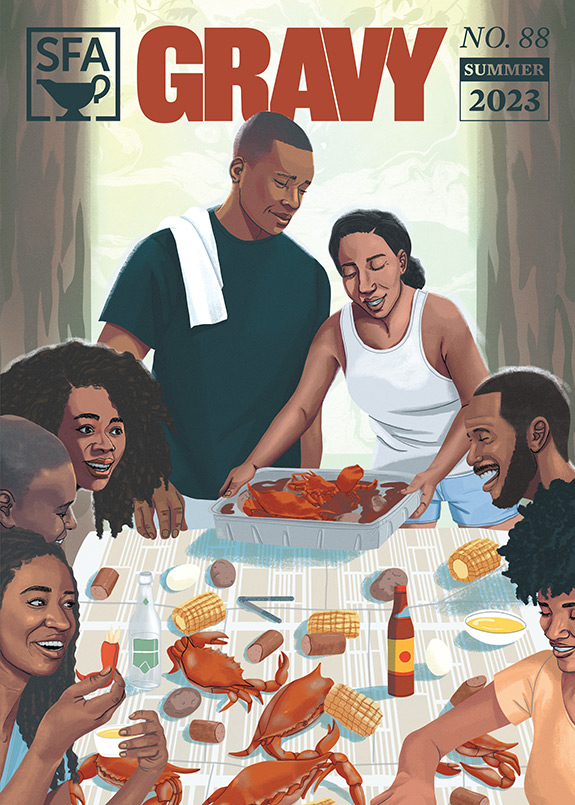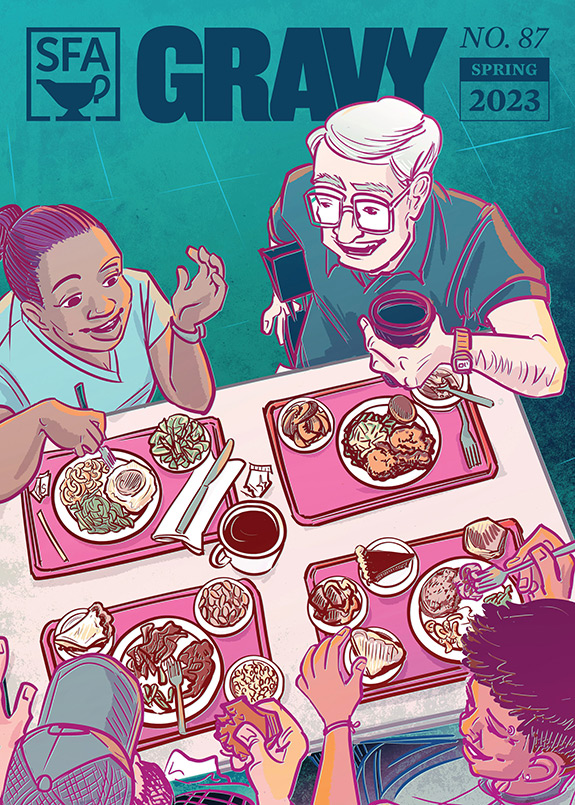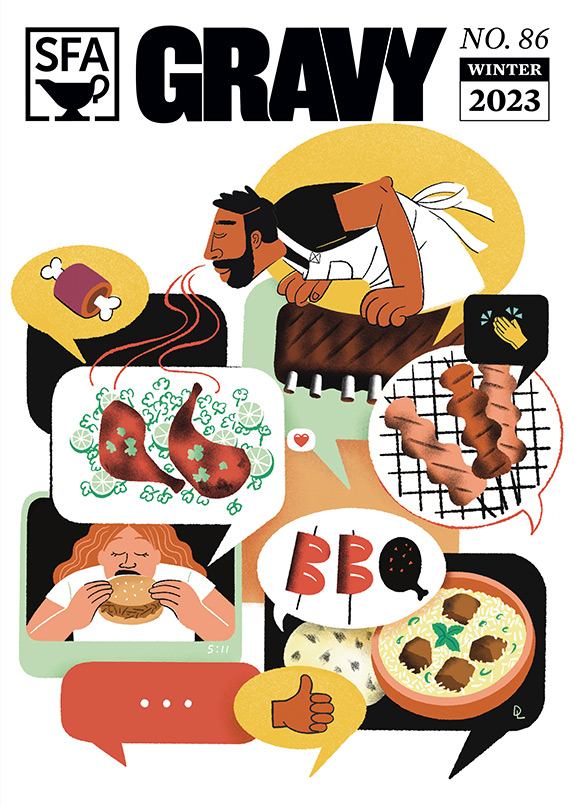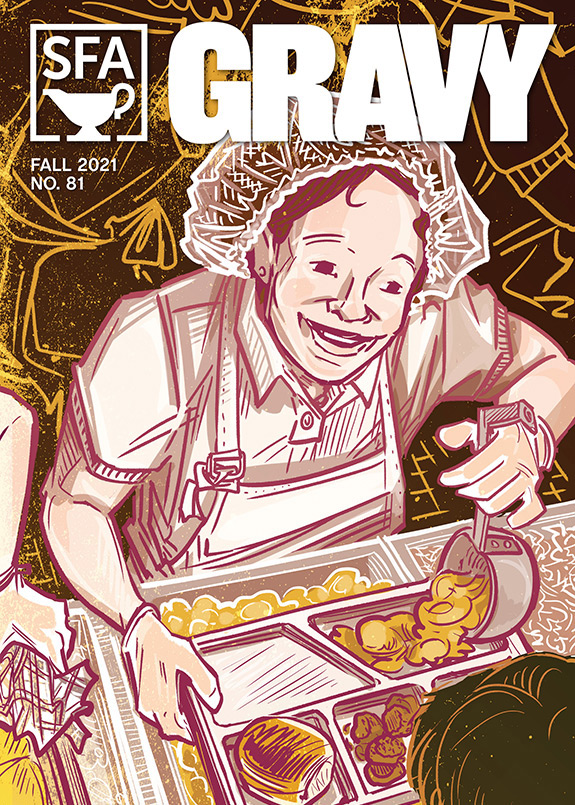
This piece originally appeared in issue #51 of our Gravy quarterly.
My Favorite Hillbilly Ingredients
An interview with Sean Brock, who earned his James Beard Award at the helm of McCrady’s in Charleston, South Carolina, but learned to love cooking in the coalfields of Wise, Virginia. His first cookbook, Heritage, will be published in October.
What are some Appalachian ingredients that the rest of the South doesn’t know about—or doesn’t appreciate—but should? What makes them worth introducing to your pantry in Raleigh, or Memphis, or New Orleans?
PAW PAWS
I grew up eating these a lot when I was a child. My grandmother just loved them, and my momma despised them. You either love them or hate them. This is one of those ingredients that could really make a big difference in the Southern pantry right now. The flavor is very exotic—it reminds me of a cross between a papaya and a banana. We always went out and foraged them, but it seems like the trees are harder to find now. So many people have never tasted a paw paw. And that’s just a shame. They are hands-down one of my favorite hillbilly ingredients. At McCrady’s we like to make paw paw sherbet.
ELDERBERRIES
I used to have to pick these as a chore growing up in Wise County, Virginia. My family would turn them into wine, which I was allowed to drink. And my grandmother made an amazing jam out of them. Since the late-summer season was so short and picking them was so labor-intensive, we really only ate these on special occasions. I still have a jar of elderberry jam with my grandmother’s handwriting on the lid. I like to take the unripe berries and turn them into capers. I scatter the flowers over wild game dishes.
POKEWEED
This weed grows wild all over the South, even in my current home base of Charleston. This may be my momma’s favorite ingredient to eat. She makes these amazing fritters using the young shoots of the plant with the stem still attached. She breads them in cornmeal and fries them up in a black skillet. I love this ingredient so much that I licensed my business under the name Pokeweed Productions.
LEATHER BRITCHES
To make leather britches, you string pole beans—like a greasy bean or a turkey craw—with a needle and thread. Traditionally, you would hang the beans above a wood-burning stove to preserve them for the winter. I’d love to know more about the history of this technique. The drying of the beans develops so much umami, it’s mind blowing. My family would cover these in water with a little lard and cook them forever. The potlikker that comes off these beans tastes like roast beef!
MIXED PICKLES
A salty and sour bowl of funky cabbage, corn, and beans was always on my family’s table. My grandmother would place the blanched vegetables into a crock of salty water and let them ferment in the basement for months. She would can them and store them after they got the flavor she wanted in the crock. When it came time to eat, she would heat a little grease in a skillet and fry up the mixed pickles. It’s like a kimchee. I still make it every year.

You’re an avid seed saver, and you have worked with David Shields and Glenn Roberts to bring back Lowcountry rice varieties that were on the brink of disappearing. Is there an Appalachian species—some kind of bean or corn, for example—that you’d like to revive in a similar manner?
I’m totally obsessed with old Southern beans and peas. I definitely could be on an episode of Hoarders if they ever saw my collection. I have hundreds of varieties tucked away in an old, beat-up chest freezer. The greasy beans of my childhood are certainly my favorite, and it’s nearly impossible to sit down in a Southern restaurant and find them on a plate. Its time we change that. Studying the varying flavors of each particular bean will keep me busy for the rest of my life.
How did growing up in Appalachia shape your values, tastes, or approaches as a chef?
I got to see the hard work and passion that goes into creating a soulful plate of food. I now understand that poor people food is the best food, and I know why: When you don’t have a whole lot, the highlight of your day is when you sit down to share a meal with your family. And when you realize that, you put a lot more care and effort into providing a good time for your loved ones. When you are at the table with them, nothing else matters. The grandest cuisine is the food cooked by a loving grandmother. It’s impossible to have a better experience, no matter how fancy or expensive a meal is.
If you were asked to cook one meal that encapsulated your hometown, what would it be?
I would go to the market and pick three or four of the most gorgeous vegetables I could find and prepare them simply—some barely cooked, and some cooked to death. I’d make killed lettuce and poke fritters. I’d go down to the basement and pull some mixed pickles and some sour corn. I’d make a skillet of real cornbread and a big cathead biscuit. I would arrange a huge platter of sliced cucumbers, banana peppers, raw onions, and ripe tomatoes. I’d cook a pot of leather britches flavored with a chunk of Benton’s jowl bacon, or a crockpot full of soup beans. There would be some ramps on the table for sure, just cooked down in a little butter. I’d end the meal with my grandmother’s sorghum-apple stack cake and a nice glass of bourbon…or three. Sounds good, doesn’t it?








